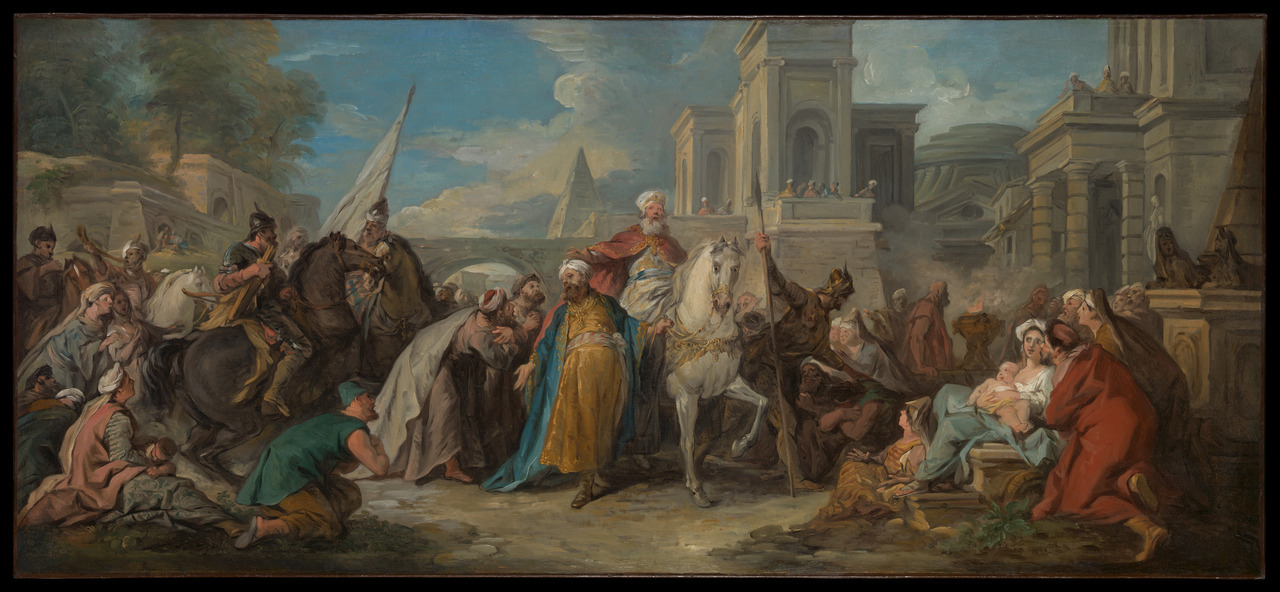The Triumph of Mordecai
Jean François de Troy
French ca. 1736

The painting belongs to a series inspired by the Old Testament book of Esther and shows her kinsman Mordecai riding triumphantly through the streets of Susa, led by his enemy Haman.
In 1736 de Troy undertook seven enormous cartoons representing the story of Esther for the Gobelin tapestry works. The final cartoon for The Triumph of Mordecai (Musée du Louvre, Paris) was completed in Rome, probably in 1739, and the first tapestry was woven between 1741 and 1744. The present work is a preliminary sketch.
In 1736 de Troy undertook seven enormous cartoons representing the story of Esther for the Gobelin tapestry works. The final cartoon for The Triumph of Mordecai (Musée du Louvre, Paris) was completed in Rome, probably in 1739, and the first tapestry was woven between 1741 and 1744. The present work is a preliminary sketch.
Catalogue Entry
Jean François de Troy studied under his father, the portraitist François de Troy (1645–1730), then at the school of the Académie Royale de Peinture et de Sculpture. He spent the years 1699 to 1706 in Italy. Later the younger de Troy was received into the Académie as a history painter, though he worked in various genres, specializing in tableaux de modes - detailing contemporary fashions and customs - as well as religious and mythological subjects. In 1734 and 1737 he contributed to the decoration of the palaces of Versailles and Fontainebleau.
In 1736, de Troy was commissioned to design seven scenes from the Old Testament book of Esther for the Gobelins tapestry manufactory. The story of Esther, the Jewish queen of the Persian king Ahasuerus, had been dramatized as a tragedy by Jean Baptiste Racine (1639–1699) in 1689. This preliminary sketch for the cartoon (Musée du Louvre, Paris) shows Esther's uncle Mordecai led in honor through the city of Susa by Haman. Mordecai, who had saved the king's life, was appointed chief minister. The cartoon was prepared in Rome, de Troy having been appointed director of the French academy there in 1738. The sketch, cartoon, and tapestry (Mobilier National, Paris) depict the crowded scene in vibrant colors and great detail. The cartoon, exhibited at the 1740 Salon, was engraved by Pierre Ignace Parrocel (1702–ca. 1775) and Jacques Firmin Beauvarlet (1731–1797). The tapestries were woven between 1738 and 1744 and at various times later in the eighteenth century.
Katharine Baetjer 2013
Jean François de Troy studied under his father, the portraitist François de Troy (1645–1730), then at the school of the Académie Royale de Peinture et de Sculpture. He spent the years 1699 to 1706 in Italy. Later the younger de Troy was received into the Académie as a history painter, though he worked in various genres, specializing in tableaux de modes - detailing contemporary fashions and customs - as well as religious and mythological subjects. In 1734 and 1737 he contributed to the decoration of the palaces of Versailles and Fontainebleau.
In 1736, de Troy was commissioned to design seven scenes from the Old Testament book of Esther for the Gobelins tapestry manufactory. The story of Esther, the Jewish queen of the Persian king Ahasuerus, had been dramatized as a tragedy by Jean Baptiste Racine (1639–1699) in 1689. This preliminary sketch for the cartoon (Musée du Louvre, Paris) shows Esther's uncle Mordecai led in honor through the city of Susa by Haman. Mordecai, who had saved the king's life, was appointed chief minister. The cartoon was prepared in Rome, de Troy having been appointed director of the French academy there in 1738. The sketch, cartoon, and tapestry (Mobilier National, Paris) depict the crowded scene in vibrant colors and great detail. The cartoon, exhibited at the 1740 Salon, was engraved by Pierre Ignace Parrocel (1702–ca. 1775) and Jacques Firmin Beauvarlet (1731–1797). The tapestries were woven between 1738 and 1744 and at various times later in the eighteenth century.
Katharine Baetjer 2013


No comments:
Post a Comment